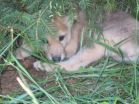(Press-News.org) AMHERST, Mass. – Dogs and wolves are genetically so similar, it's been difficult for biologists to understand why wolves remain fiercely wild, while dogs can gladly become "man's best friend." Now, doctoral research by evolutionary biologist Kathryn Lord at the University of Massachusetts Amherst suggests the different behaviors are related to the animals' earliest sensory experiences and the critical period of socialization. Details appear in the current issue of Ethology.
Until now, little was known about sensory development in wolf pups, and assumptions were usually extrapolated from what is known for dogs, Lord explains. This would be reasonable, except scientists already know there are significant differences in early development between wolf and dog pups, chief among them timing of the ability to walk, she adds.
To address this knowledge gap, she studied responses of seven wolf pups and 43 dogs to both familiar and new smells, sounds and visual stimuli, tested them weekly, and found they did develop their senses at the same time. But her study also revealed new information about how the two subspecies of Canis lupus experience their environment during a four-week developmental window called the critical period of socialization, and the new facts may significantly change understanding of wolf and dog development.
When the socialization window is open, wolf and dog pups begin walking and exploring without fear and will retain familiarity throughout their lives with those things they contact. Domestic dogs can be introduced to humans, horses and even cats at this stage and be comfortable with them forever. But as the period progresses, fear increases and after the window closes, new sights, sounds and smells will elicit a fear response.
Through observations, Lord confirmed that both wolf pups and dogs develop the sense of smell at age two weeks, hearing at four weeks and vision by age six weeks on average. However, these two subspecies enter the critical period of socialization at different ages. Dogs begin the period at four weeks, while wolves begin at two weeks. Therefore, how each subspecies experiences the world during that all-important month is extremely different, and likely leads to different developmental paths, she says.
Lord reports for the first time that wolf pups are still blind and deaf when they begin to walk and explore their environment at age two weeks. "No one knew this about wolves, that when they begin exploring they're blind and deaf and rely primarily on smell at this stage, so this is very exciting," she notes.
She adds, "When wolf pups first start to hear, they are frightened of the new sounds initially, and when they first start to see they are also initially afraid of new visual stimuli. As each sense engages, wolf pups experience a new round of sensory shocks that dog puppies do not."
Meanwhile, dog pups only begin to explore and walk after all three senses, smell, hearing and sight, are functioning. Overall, "It's quite startling how different dogs and wolves are from each other at that early age, given how close they are genetically. A litter of dog puppies at two weeks are just basically little puddles, unable to get up or walk around. But wolf pups are exploring actively, walking strongly with good coordination and starting to be able to climb up little steps and hills."
These significant, development-related differences in dog and wolf pups' experiences put them on distinctly different trajectories in relation to the ability to form interspecies social attachments, notably with humans, Lord says. This new information has implications for managing wild and captive wolf populations, she says.
Her experiments analyzed the behavior of three groups of young animals: 11 wolves from three litters and 43 dogs total. Of the dogs, 33 border collies and German shepherds were raised by their mothers and a control group of 10 German shepherd pups were hand-raised, meaning a human was introduced soon after birth.
At the gene level, she adds, "the difference may not be in the gene itself, but in when the gene is turned on. The data help to explain why, if you want to socialize a dog with a human or a horse, all you need is 90 minutes to introduce them between the ages of four and eight weeks. After that, a dog will not be afraid of humans or whatever else you introduced. Of course, to build a real relationship takes more time. But with a wolf pup, achieving even close to the same fear reduction requires 24-hour contact starting before age three weeks, and even then you won't get the same attachment or lack of fear."
INFORMATION:
Why wolves are forever wild, but dogs can be tamed
Dogs and wolves are genetically so similar, it's been difficult for biologists to understand why wolves remain fiercely wild, while dogs can gladly become 'man's best friend'
2013-01-18
ELSE PRESS RELEASES FROM THIS DATE:
Health and law expert: NFL not alone in handling concussions as 'benign' problems
2013-01-18
INDIANAPOLIS -- More than 2,000 former football players are suing the National Football League, saying the league should have taken action earlier to deal with injuries related to concussions more seriously.
But if a lack of speed in tackling concussions warrants criticism, the NFL isn't the only player deserving a penalty, according to a study co-authored by health care and law expert David Orentlicher, who teaches at Indiana University Robert H. McKinney School of Law in Indianapolis.
Neurologists were also slow in sounding the alarm, and for decades, concussions ...
New study challenges links between day care and behavioral issues
2013-01-18
CHESTNUT HILL, MA (Jan. 17, 2013) – A new study that looked at more than 75,000 children in day care in Norway found little evidence that the amount of time a child spends in child care leads to an increase in behavioral problems, according to researchers from the United States and Norway.
Several prior studies in the U.S. made connections between the time a child spends in day care and behavioral problems, but the results from Norway contradict those earlier findings, the researchers report in the online version of the journal Child Development.
"In Norway, we do not ...
Study findings have potential to prevent,reverse disabilities in children born prematurely
2013-01-18
PORTLAND, Ore. – Physician-scientists at Oregon Health & Science University Doernbecher Children's Hospital are challenging the way pediatric neurologists think about brain injury in the pre-term infant. In a study published online in the Jan. 16 issue of Science Translational Medicine, the OHSU Doernbecher researchers report for the first time that low blood and oxygen flow to the developing brain does not, as previously thought, cause an irreversible loss of brain cells, but rather disrupts the cells' ability to fully mature. This discovery opens up new avenues for potential ...
Want to ace that interview? Make sure your strongest competition is interviewed on a different day
2013-01-18
Whether an applicant receives a high or low score may have more to do with who else was interviewed that day than the overall strength of the applicant pool, according to new research published in Psychological Science, a journal of the Association for Psychological Science.
Drawing on previous research on the gambler fallacy, Uri Simonsohn of The Wharton School of the University of Pennsylvania and Francesca Gino of Harvard Business School hypothesized that admissions interviewers would have a difficult time seeing the forest for the trees. Instead of evaluating applicants ...
In minutes a day, low-income families can improve their kids' health
2013-01-18
URBANA – When low-income families devote three to four extra minutes to regular family mealtimes, their children's ability to achieve and maintain a normal weight improves measurably, according to a new University of Illinois study.
"Children whose families engaged with each other over a 20-minute meal four times a week weighed significantly less than kids who left the table after 15 to 17 minutes. Over time, those extra minutes per meal add up and become really powerful," said Barbara H. Fiese, director of the U of I's Family Resiliency Program.
Childhood obesity ...
Understanding personality for decision-making, longevity, and mental health
2013-01-18
January 17, 2013 – New Orleans – Extraversion does not just explain differences between how people act at social events. How extraverted you are may influence how the brain makes choices – specifically whether you choose an immediate or delayed reward, according to a new study. The work is part of a growing body of research on the vital role of understanding personality in society.
"Understanding how people differ from each other and how that affects various outcomes is something that we all do on an intuitive basis, but personality psychology attempts to bring scientific ...
World's most complex 2-D laser beamsteering array demonstrated
2013-01-18
Most people are familiar with the concept of RADAR. Radio frequency (RF) waves travel through the atmosphere, reflect off of a target, and return to the RADAR system to be processed. The amount of time it takes to return correlates to the object's distance. In recent decades, this technology has been revolutionized by electronically scanned (phased) arrays (ESAs), which transmit the RF waves in a particular direction without mechanical movement. Each emitter varies its phase and amplitude to form a RADAR beam in a particular direction through constructive and destructive ...
NASA beams Mona Lisa to Lunar Reconnaissance Orbiter at the moon
2013-01-18
VIDEO:
NASA Goddard scientists transmitted an image of the Mona Lisa from Earth to the Lunar Reconnaissance Orbiter at the moon by piggybacking on laser pulses that routinely track the spacecraft.
HD...
Click here for more information.
As part of the first demonstration of laser communication with a satellite at the moon, scientists with NASA's Lunar Reconnaissance Orbiter (LRO) beamed an image of the Mona Lisa to the spacecraft from Earth.
The iconic image traveled ...
Titan gets a dune 'makeover'
2013-01-18
Titan's siblings must be jealous. While most of Saturn's moons display their ancient faces pockmarked by thousands of craters, Titan – Saturn's largest moon – may look much younger than it really is because its craters are getting erased. Dunes of exotic, hydrocarbon sand are slowly but steadily filling in its craters, according to new research using observations from NASA's Cassini spacecraft.
"Most of the Saturnian satellites – Titan's siblings – have thousands and thousands of craters on their surface. So far on Titan, of the 50 percent of the surface that we've seen ...
Stroke survivors with PTSD more likely to avoid treatment
2013-01-18
New York, NY — A new survey of stroke survivors has shown that those with post-traumatic stress disorder (PTSD) are less likely to adhere to treatment regimens that reduce the risk of an additional stroke. Researchers found that 65 percent of stroke survivors with PTSD failed to adhere to treatment, compared with 33 percent of those without PTSD. The survey also suggests that nonadherence in PTSD patients is partly explained by increased ambivalence toward medication. Among stroke survivors with PTSD, approximately one in three (38 percent) had concerns about their medications. ...
LAST 30 PRESS RELEASES:
Making lighter work of calculating fluid and heat flow
Normalizing blood sugar can halve heart attack risk
Lowering blood sugar cuts heart attack risk in people with prediabetes
Study links genetic variants to risk of blinding eye disease in premature infants
Non-opioid ‘pain sponge’ therapy halts cartilage degeneration and relieves chronic pain
AI can pick up cultural values by mimicking how kids learn
China’s ecological redlines offer fast track to 30 x 30 global conservation goal
Invisible indoor threats: emerging household contaminants and their growing risks to human health
Adding antibody treatment to chemo boosts outcomes for children with rare cancer
Germline pathogenic variants among women without a history of breast cancer
Tanning beds triple melanoma risk, potentially causing broad DNA damage
Unique bond identified as key to viral infection speed
Indoor tanning makes youthful skin much older on a genetic level
Mouse model sheds new light on the causes and potential solutions to human GI problems linked to muscular dystrophy
The Journal of Nuclear Medicine ahead-of-print tip sheet: December 12, 2025
Smarter tools for peering into the microscopic world
Applications open for funding to conduct research in the Kinsey Institute archives
Global measure underestimates the severity of food insecurity
Child survivors of critical illness are missing out on timely follow up care
Risk-based vs annual breast cancer screening / the WISDOM randomized clinical trial
University of Toronto launches Electric Vehicle Innovation Ontario to accelerate advanced EV technologies and build Canada’s innovation advantage
Early relapse predicts poor outcomes in aggressive blood cancer
American College of Lifestyle Medicine applauds two CMS models aligned with lifestyle medicine practice and reimbursement
Clinical trial finds cannabis use not a barrier to quitting nicotine vaping
Supplemental nutrition assistance program policies and food insecurity
Switching immune cells to “night mode” could limit damage after a heart attack, study suggests
URI-based Global RIghts Project report spotlights continued troubling trends in worldwide inhumane treatment
Neutrophils are less aggressive at night, explaining why nighttime heart attacks cause less damage than daytime events
Menopausal hormone therapy may not pose breast cancer risk for women with BRCA mutations
Mobile health tool may improve quality of life for adolescent and young adult breast cancer survivors
[Press-News.org] Why wolves are forever wild, but dogs can be tamedDogs and wolves are genetically so similar, it's been difficult for biologists to understand why wolves remain fiercely wild, while dogs can gladly become 'man's best friend'




